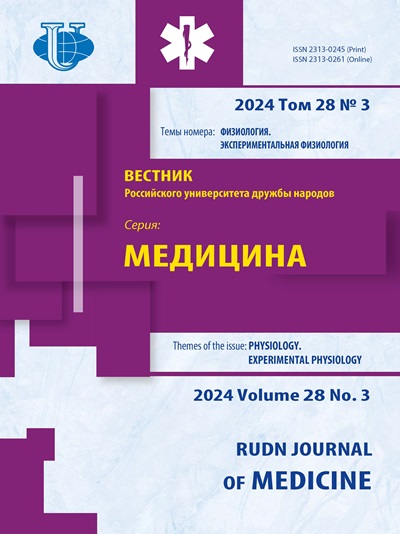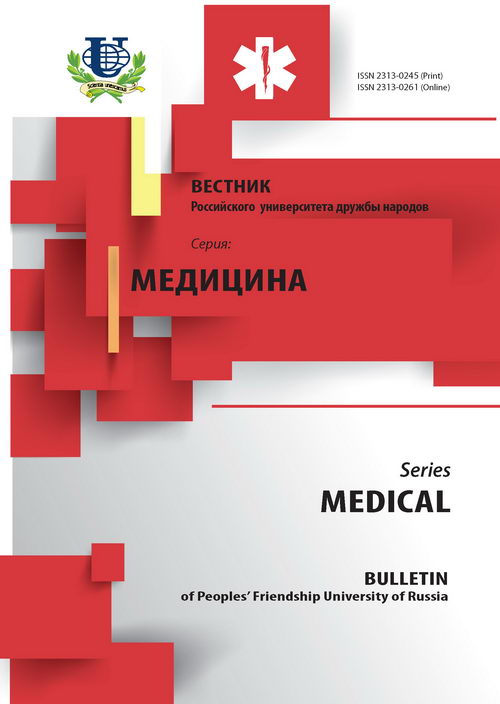Особенности мезенхимальных стромальных клеток эндометрия в норме и при различных гинекологических заболеваниях
- Авторы: Аникина Т.А.1, Радзинский В.Е.1, Рубина К.А.2, Сысоева В.Ю.2
-
Учреждения:
- Российский университет дружбы народов
- Московский государственный университет им. М.В. Ломоносова
- Выпуск: № S5 (2013)
- Страницы: 80-87
- Раздел: Статьи
- URL: https://journals.rudn.ru/medicine/article/view/3433
Цитировать
Полный текст
Аннотация
Об авторах
Тамара Александровна Аникина
Российский университет дружбы народов
Email: anikinatamara@mail.ru
Кафедра акушерства и гинекологии с курсом перинатологии Медицинский факультет
Виктор Евсеевич Радзинский
Российский университет дружбы народов
Email: radzinsky@mail.ru
Кафедра акушерства и гинекологии с курсом перинатологии Медицинский факультет
Ксения Андреевна Рубина
Московский государственный университет им. М.В. Ломоносова
Email: rkseniya@mail.ru
Факультет фундаментальной медицины
Вероника Юрьевна Сысоева
Московский государственный университет им. М.В. Ломоносова
Email: veroniks@mail.ru
Факультет фундаментальной медицины
Список литературы
- Caplan A.I. Adult mesenchymal stem cells for tissue engineering versus regenerative medicine // J. Cell Physiol. — 2007. — 213. — P. 341—347.
- Cervello I., Simon C. Somatic stem cells in the endometrium // Reprod sci. — 2009. — 16 (2). — P. 200—205.
- Cervello I., Martinez-Romero A., Martinez-Conerjero J.A. et al. Is the side — population phenotype an essential characteristic for the stem cells in human endometrium? // Reprod. Sci. — 2008. — 15 (suppl 2): 72A.
- Cervello I., Mas A., Gil-Sanchis C., Peris L., Faus A. et al. Reconstruction of endometrium from human endometrial side population cell lines // PLoS ONE. — 2011. — 6(6): e21221.
- Conget P.A., Minguell J.J. Phenotypical and functional properties of human bone-marrow mesenchimal progenitor cells // J. Cell. Physiol. — 1999. — № 181. — P. 67—73.
- Covas D.T., Panepucci R.A., Fontes A.M., Silva W.A., Orellana M.D., Freitas M.C., Neder L., Santos A.R., Peres L.C., Jamur M.C., Zago M.A. Multipotent mesenchymal stromal cells obtained from diverse human tissues share functional properties and gene-expression profile with CD146+ perivascular cells and fibroblasts // Exp. Hematol. — 2008. — 36 (5). — P. 642—54.
- Crisan M., Yap S., Castellia L., Chen C.W., Corselli M., Park T.S., Andriolo G., Sun B., Zheng B., Zhang L., Norotte C., Teng P.N. et al. A periavscular origin for mesenchimal stem cells in multiple human organs // Cell Stem Cell. — 2008. — 3. — P. 301—313.
- Diaz-Flores L., Gutierrez R., Madrid J.F. Pericytes. Morphofunction, interactions and pathology in a quiescent and activated mesenchymal cell niche // Histol. Histopathol. — 2009. — 24 (7). — P. 909—69.
- Dominici M., Le B.K., Mueller I., Slaper-Cortenbach I., Marini F., Krause D., Deans R., Keating A., Prockop D., Horwitz E. Minimal criteria for defining multipotent mesenchimal stromal cells. The international society for cellular therapy position statement // Cytotherapy. — 2006. — 8. — P. 315—317.
- Gargett C.E., Chan R.W., Shwarb K.E. Hormone and growth factor signaling in endometrial renewal: role of stem/ progenitor cells // Mol. Cell Endocrinol. — 2008. — 288(1—2). — P. 22—9.
- Gargett C.E., Masuda H. Adult stem cells in the endometrium // Mol. Hum. Reprod. — 2010. — 16(11). — P. 818—34. doi: 10.1093/molehr/gaq061.
- Gargett C.E., Schwarb K.E., Zillwood R.M., Nguyen H., Di Wo. Isolation and culture of epitelial progenitors and mesenchimal stem cells from the human endometrium // Biol. Reprod. — 2009. — 80(6). — P. 1136—45. doi: 10.1095/biolreprod.108.075226.
- Kyurkchiev S., Shterev A., Dimitrov R. Assessment of presence and characteristics of multipotent stromal cells in human endometrium and decidua // Reprod. Biolmed. Online. — 2010. — 20(3). — P. 305—13. doi: 10.1016/j.rbmo.2009.12.011.
- Maruyama T., Yoshimura Y. Molecular and cellular mechanisms for differentiation and regeneration of uterine endometrium // Endocr. J. 2008, 55(5): 795—810.
- Masuda H., Matsuzaki Y., Hiratsu E., Ono M., Nagahashi T. et al. Stem cell-like properties of the endometrial side population: implication in endometrial regeneration // PLoS ONE. — 2010. — 5(4): e10387.
- Mosna F., Sensebe L., Krampera M. Human bone marrow and adipose tissue mesenchymal stem cells: a user's guide // Stem Cell Dev. — 2010. — 19(10). — P. 1449—70. doi: 10.1089/scd.2010.0140.
- Musina R.A., Belyavski A.V., Tarusova O.V., Solovyova E.V., Sukhikh G.T. Endometrial mesenchimal stem cells isolated from the menstrual blood // Bulletin of Experimental Biology and Medicine. — 2008. — 145 (4). — P. 539—543.
- Patel A.N., Silva F. Menstrual blood stromal cells: the potential for regenerative medicine // Reprod Med. — 2008. — 3(4). — P. 443—444.
- Russell K.C., Phinney D.G., Lacey M.R., Barrilleaux B.L., Meyertholen K.E., O'Connor K.C. In vitro high-capacity assay to quantify the clonal heterogeneity in trilineage potential of mesenchymal stem cells reveals a complex hierarchy of lineage commitment // Stem Cells. — 2010. — 28(4). — P. 788—98. doi: 10.1002/stem.312.
- Schwab K.E., Hutchinson P., Gargett C.E. Identification of surface markers for prospective isolation of human endometrial stromal colony-forming cells // Hum Reprod. — 2008. — 23(4). — P. 934—43.
- Zimmerlin L., Donnenberg V.S, Rubin J.P., Donnenberg A.D. Mesenchimal markers on human adipose stem/progenitors cells // Cytometry Part A. — 2013. — 83A(1). — P. 134—140.
















